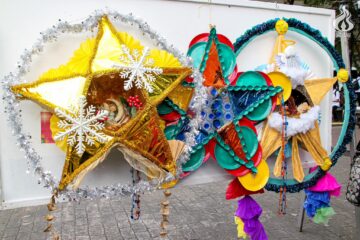by CHRISTINE JANINE T. CORTEZ
THE PROMISE of tomorrow comes in like ocean waves; it comes and it goes. But unlike the days, three-fourths of the natural world is made out of water –– something that the modern generation of people often takes for granted.
It should be widely addressed that the earth’s natural waters, unlike man-made possessions, cannot be reproduced. Water, at some point in time, will run out eventually if the people continue to ignore the dawning effects of environmental problems.

Therefore, as a way to rouse everyone of this universal phenomenon, Altro Mondo Arte Contemporanea together with Kunstmatrix exhibited a visual art show featuring the global history of oceans through the lenses of a Filipino artist and seafarer Joar Songcuya.
The show, which ran from Jan.16 until Feb. 14, 2021, is titled “The History of Water”. It mirrors the lives of men at sea, using the ocean’s water as the essential element that ties everything together. Curated by the poet Charlie Samuya Veriche, the show is a visual mix of art and poetry as told through the different facets of water.

Once inside the guided tour, suddenly there are ringing sounds of waves rippling and crashing, hordes of seagulls making noise, and ships honking simultaneously. The noise was startling at first, but by the time that feeling passed, slowly everything made sense.

The painting titled Sunset stood out in the collection because its colors slightly deviated from the consistent moods of blue, white, and faint tones of orange. Although it was a gamble to stray away from the accentuated colors, it could now point to a foreign characteristic or perhaps the artist’s intervening emotions.
While engulfed with the endless vastness of blues above and below, Songcuya made use of his deep inclination to art and allowed himself to paint his visions and feelings into life. By embodying water in its purest form, his paintings were able to emulate how water acts and flows on different occasions.

The painting Drifter; Lifeboat shows a red-colored lifeboat stuck between the bright sky and the deep sea. In a nutshell, it looks like a contrast between light and darkness that was mediated by the lifeboat on its center.
It could mean a lot of things. But for some reason, the presence of the lifeboat evokes a sense of hope. On the other hand, to tell whether it was going toward or away from the artist leaves audiences a little curious. One may even ask, “Is it on its way to save him? Or is it not?”

The Mediterranean Lighthouse looked like a visual snippet of time in one of Songcuya’s voyages. Although many artists have already done a lighthouse painting, it does not always happen that the painter is an actual sailor.
When a person looks at his paintings, it gives off a feeling that one is actually riding a ship and looking through a window. The ocean felt so real that the artist was effective in making his viewers experience what he and every other seafarer felt out on the ocean.

For some people, drawing out a picture from impressionism art may be a challenging task because the objects are not clearly defined. Therefore, it was a good thing that Songcuya named his paintings with their corresponding subjects. That way, people could easily get the picture.

It is important to note that water is not the only thing he painted. The collection, all together, is like a personal diary that documented his memories and feelings. As a result, what the audiences saw was not just water on canvas, it was the artist himself.
Songcuya embraced his subject enough for the bodies of water to speak themselves and the message they wanted to convey. That they are in fact, more than just a reservoir created to satisfy the necessities of man.
As cliché as this may sound, man is the only one responsible to sustain the life of water. After all, it was men who dumped mountains of plastic at sea. It was men who aimlessly discarded toxic waste at sea. It was men who still refuse to acknowledge that earth’s water is not enough to last everyone a lifetime.
This is not to say that people should no longer consume water. Rather, a reminder for everyone to value things while it’s still there. People can always use water with due moderation, atop a huge responsibility to make it last for generations to come. F



